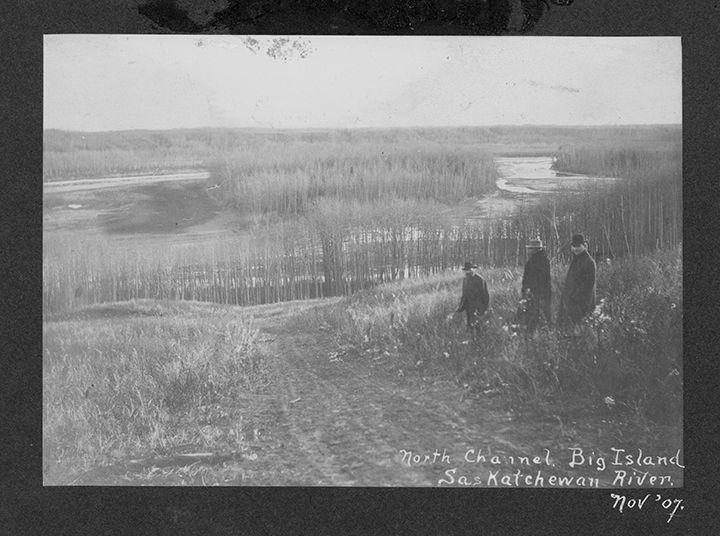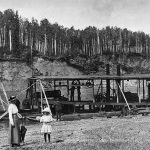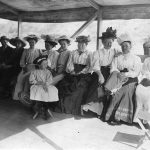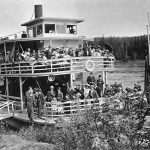Big Island, a 70-acre island located 16 miles upstream from the city of Edmonton, is a lesser-known piece of Edmonton’s history. Edmonton is a river city; formerly a fur trading post strategically situated within a network of prairie waterways, Edmonton’s story has been deeply influenced by the timeless flow of the North Saskatchewan River. Located only a short distance upstream from the growing settlement, Big Island was an important source of natural resources. Initially valued for its abundance of timber, coal and gold, Big Island also became a treasured picnic spot and rural retreat for countless Edmontonians in the late 19th and early 20th centuries and is a unique piece of Edmonton’s heritage.
In the 1880s, Big Island was an important source of timber. Its convenient location allowed timber to be cut and easily floated downstream, while the narrow channel between the island and west shore acted as a natural log boom, where stockpiled logs could be stored. John Walter, one of Edmonton’s greatest entrepreneurs, saw the value of the Island’s timber stores and purchased a timber limit in 1895. The following year, his company Walter and Humberstone harvested 300,000 feet of timber, floating it downstream to Walter’s sawmill at Walterdale. Big Island provided the raw materials for many of Edmonton’s early structures and continued to be a source of lumber into the 1920s.
Coal was also a valuable natural resource and as its demand increased with Edmonton’s growing population, the North Saskatchewan’s banks were prospected and mined throughout the region. In 1881, the Hudson Bay Company (HBC) briefly opened a strip mine on Big Island, followed by other prospectors and miners. Easy river access allowed coal to be directly loaded onto boats and taken downriver. The Island’s abundant deposits were mined throughout the 1880s and 1890s.
Gold was another precious resource the North Saskatchewan was endowed with. Gold deposits, known as placer gold, occurred in sand and gravel bars along the river. Although prospecting did not reach the fevered pitch of the Klondike Gold Rush, it did allow some gold seekers to make a respectable living mining the river’s sediments. The earliest methods of mining were done by hand, followed by the use of steam-powered dredges. In 1899, there were nine companies operating 15 dredges in the Edmonton area. The Star Mining Company operated above Big Island, using a 12-horse power dredge capable of digging gravel at a depth of 10 feet. A much larger operation belonged to the Loveland Brothers. Situated in the channel on the south side of Big Island, their dredge operated with two 20-horse power engines. Dredging operations continued at Big Island into the early years of the 20th century.
The arrival of the steamboat revolutionized river transportation and transformed Big Island into an accessible destination and a much loved picnic locale. In the 1890s, HBC steamers, the Upas and Northwest, conveyed passengers for occasional outings to the Island. A decade later, the popularity of excursions increased when John Walter began employing his own steamboats for river travel. Throughout the week, Walter’s Scona and City of Edmonton busily hauled cargo up and down the North Saskatchewan, but on weekends and holidays, they were transformed to accomodate summer excursions.
Departing mid-morning from the dock below the Low Level Bridge, a Big Island excursion was an all-day event. Once aboard, steamer passengers enjoyed refreshments and entertainment and after a three-hour journey, they arrived at the Island for a day of outdoor merriment. The Island appealed to a variety of interests. Its old growth cottonwood forest, shoreline and variety of flora and fauna provided the ideal setting for communing with Mother Nature. Aside from the pleasure of eating outdoors, picnickers enjoyed a variety of outdoor games such as egg and spoon races, potato sack races, pie eating contests and tug-of-wars. As evening fell, picnickers climbed aboard the waiting vessel, but festivities were far from over. The homeward journey was a lively affair; local musicians provided entertainment, while passengers danced under the stars to the popular tunes of the era. To an onlooker, the illuminated steamboat would have appeared as quite the spectacle, winding its way through the river valley to the sounds of music and revelry. Over the years, the Island was the setting for many festive occasions hosted by church groups, schools, unions, and organizations such as the YMCA and the Knights of Columbus. In an era where long distance holidays were uncommon, Big Island was an accessible destination for Edmontonians.
In 1911, John Walter purchased Big Island from the Dominion Government. Intending to turn the island into a summer resort, he built a large dock and made plans for a grand pavilion. Excursions to Big Island captured an idyllic time before the young city was affected by the looming hardships of the twentieth century. The outbreak of WWI compounded by the disastrous flood of 1915, ushered in a time of great loss and uncertainty. The flood took a terrible toll on John Walter’s businesses, crippling him financially. While trips to Big Island continued, Walter never recovered from his losses. In 1918, the City of Edmonton was put up for sale. Unable to find a buyer, it remained tied to its mooring at Walterdale and eventually decayed and dissolved into the mud; thus ending the most colorful chapter of Big Island’s history.
For the better part of four decades, Big Island played an important role in shaping Edmonton’s history. Valued initially for its resources, the Island became a much-loved gathering place. Then, abandoned after WWI, it faded from Edmonton’s consciousness. Edmonton’s footprint has since grown and has begun to encroach on the once distant Island. Recently, there has been an initiative to formally designate Big Island and its surrounding area as a park. If this initiative is successful, Edmonton’s river valley will be the largest urban natural area in Canada. Big Island is on the verge of a new chapter in its story and the proposed park will once again provide a natural haven for Edmontonians. In view of these conservation efforts, it is important to reflect on Big Island not only as a potential green space, but also as a valuable heritage site. Big Island offers us a window into Edmonton’s past and perhaps if one listens carefully, they might hear the faint echoes of a picnic floating on the summer breeze.
Peggy Donnelly © 2016




